
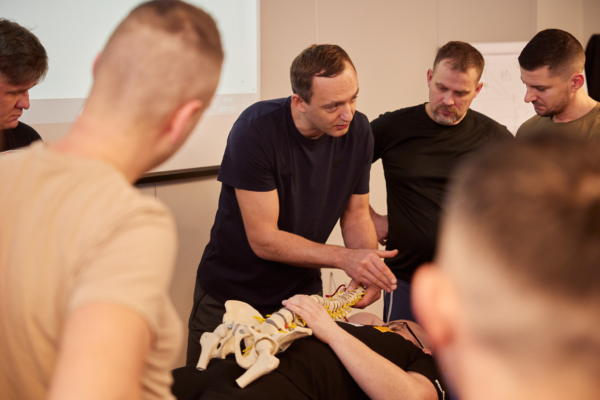
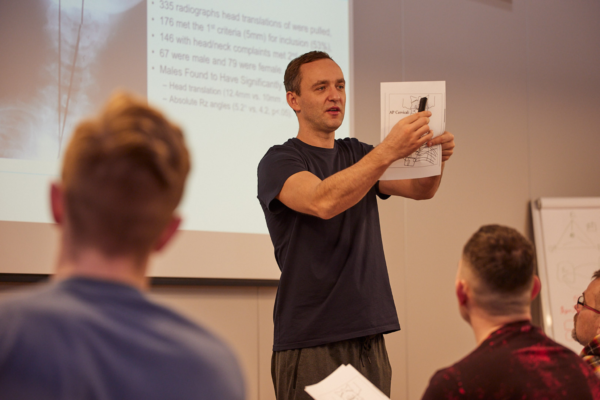
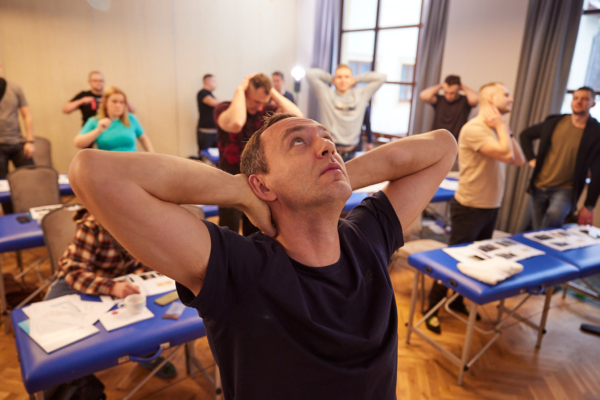

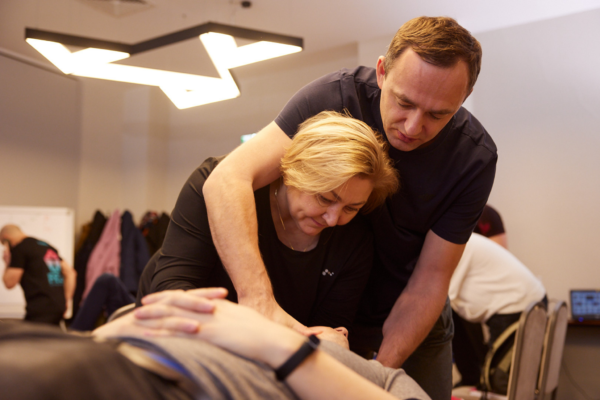
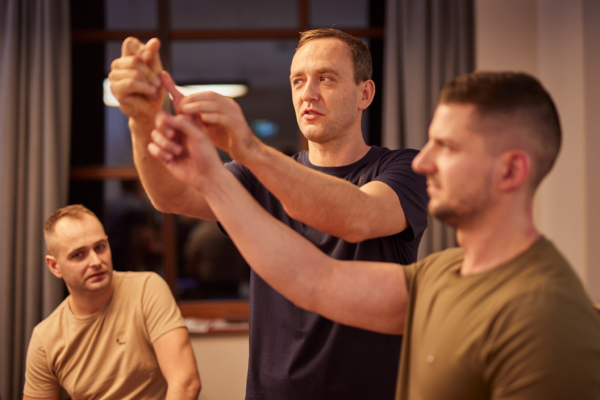

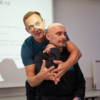
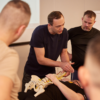
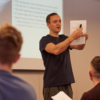


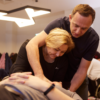

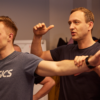
MANUAL THERAPY IN THE CHIROPRACTICAL CONCEPT. Differential diagnosis and radiology.
3 500,00 zł
4-day training, during which Łukasz presents the chiropractic manipulation techniques he uses in his office. His individual approach and the role of spine radiographs in patient diagnostics in selected cases are also discussed.
37 godzin
hours
45 educational
points
Place:
Spała / Big Cities
Funding
KFS / BUR
Based on his specialized education and many years of office experience, Doctor of Chiropractic Łukasz Matusiewicz has prepared his own training: MANUAL THERAPY IN THE CHIROPRACTIC CONCEPT. Differential diagnosis and radiology - introducing the world of chiropractic, manipulation techniques and imaging studies.
What will you learn?
- You will learn about safe, painless and effective techniques for manipulating the spine and peripheral joints from a chiropractic perspective, as well as relative and absolute contraindications to this form of therapy.
- You will become familiar with methods of diagnosing and treating structural disorders of the musculoskeletal system (muscles, ligaments, nerves) that affect disorders in the spine and peripheral joints.
- You will learn how to read imaging studies (X-ray and MRI) of the spine in patient diagnostics in selected cases and how to use this knowledge in your therapeutic work through precise analysis of the bone and tissue structure.
- You will learn about the individual approach of the instructor, based on the philosophy of indigenous chiropractic according to D.D. Palmer, many years of experience in office work and analysis of the results of work with patients.

Co wyróżnia szkolenie Terapia manualna w koncepcji chiropraktycznej?
- Experienced practitioner with a Doctor of Chiropractic degree (USA).
Doctor of Chiropractic Łukasz Matusiewicz graduated from Life University in the USA in 2013 and since then has been practicing and constantly deepening his knowledge and sharing his experience in Poland and abroad. - Four days of intensive theory and practice.
This training is distinguished by its clinical and practical aspect, the core of which is not memorizing test patterns, but understanding the phenomena and symptoms with which the patient comes. - An atmosphere conducive to deepening and acquiring new knowledge.
Knowledge conveyed in an accessible and understandable way. You will practice each technique on the couch under the supervision of the instructor, and you will also experience each of the discussed techniques yourself. - Building your own, unique method of working with the patient.
The aim of this course is not only to provide you with techniques and protocols for their practical application, but above all to inspire you to think independently and design your own therapeutic work protocols. - A script containing the most important issues.
Materials you can always return to after completing the training. - Closed course group.
Joining a closed course group where, even after completing the course, you can consult with the instructor and share your office cases with others.
For whom is this course?
Manual therpay in chiropractic concept is a training that meets the current needs of physiotherapists, chiropractors, osteopaths, massage therapists and representatives of other medical professions who want to explore the secrets of indigenous chiropractic and complement their therapeutic workshop.
WEBINAR:
Diagnostic imagining (MRI and X-ray) of the cervical spine in chiropractic
Watch a webinar during which you will learn why Łukasz Matusiewicz uses imaging studies in his practice, what to look for when reading imaging. You will learn about red flags and how the structure of the cervical spine affects its function.
WEBINAR:
Analiza odcinka szyjnego C0-C3 na podstawie badań radiologicznych
Czy wiesz, że szczegółowa analiza rentgenowska górnego odcinka szyjnego może być kluczowa w trafnej diagnostyce i skutecznej terapii Twoich pacjentów?
Obejrzyj webinar, podczas którego pokazuję, jak krok po kroku oceniać struktury C0-C3 za pomocą badań radiologicznych.
09:00 – 09:45
Wprowadzenie, przedstawienie się uczestników.
09:45 – 10:30
Badania w chiropraktyce oraz filozofia chiropraktyki.
10:30 – 10:45
Break
10:45 – 11:30
Biomechanika i neurologia manipulacji kręgosłupa. Wskazania i przeciwskazania do zabiegu.
11:30 – 12:15
Palpacja i analiza górnego odcinka szyjnego C0-C2.
12:15 – 12:30
Break
12:30 – 13:15
Praca na tkankach miekkich w odcinku szyjnym cz.1
13:15 – 14:00
Praca na tkankach miekkich w odcinku szyjnym cz.2
14:00 – 15:00
Break
15:00 – 15:45
Palpacja i analiza odcinka szyjnego C3-C7.
15:45 – 16:30
Palpacja i analiza pierwszego żebra oraz górnego odcinka szyjnego.
16:30 – 16:45
Break
16:45 – 17:30
Rentgenometria odcinka szyjnego.
17:30 – 18:15
Analiza i czytanie zdjęć RTG w odcinku szyjnym.
09:00 – 09:45
Przypomnienie palpacji oraz analizy strukturalnej odcinka szyjnego.
09:45 – 10:30
Przypomnienie i utrwalenie manipulacji pierwszego żebra oraz górnego odcinka piersiowego
10:30 – 10:45
Break
10:45 – 11:30
Palpacja i analiza odcinka piersiowego.
11:30 – 12:15
Praca na tkankach miękkich w odcinku piersiowym.
12:15 – 12:30
Break
12:30 – 13:15
Filozofia chiropraktyki
13:15 – 14:00
Analiza i czytanie zdjęć MRI odcinka szyjnego
14:00 – 15:00
Break
15:00 – 15:45
Palpacja i analiza kompleksu barkowego.
15:45 – 16:30
Manipulacje stawowe: nadgarstek i łokieć.
16:30 – 16:45
Break
16:45 – 17:30
Analiza i czytanie zdjęć RTG odcinka piersiowego i lędźwiowego.
17:30 – 18:15
Analiza i czytanie zdjęć MRI odcinka piersiowego i lędźwiowego
09:00 – 09:45
Przypomnienie i utrwalenie manipulacji stawowych w odcinku szyjnym i piersiowym.
09:45 – 10:30
Palpacja i analiza odcinka lędźwiowego oraz kości krzyżowej cz.1
10:30 – 10:45
Break
10:45 – 11:30
Palpacja i analiza odcinka lędźwiowego oraz kości krzyżowej cz.2
11:30 – 12:15
Praca na tkankach miękkich w odcinku lędźwiowo-krzyżowym.
12:15 – 12:30
Break
12:30 – 13:15
Palpacja i analiza stawu biodrowego.
13:15 – 14:00
RTG stawu biodrowego
14:00 – 15:00
Break
15:00 – 15:45
Manipulacje stawowe oraz praca na tkankach miękkich: staw skokowy.
15:45 – 16:30
Manipulacje stawowe oraz praca na tkankach miękkich: kolano.
16:30 – 16:45
Break
16:45 – 17:30
Analiza i czytanie zdjęć RTG i MRI kręgosłupa.
17:30 – 18:15
Praktyka manipulacji stawowych w odcinku szyjnym i lędźwiowym.
09:00 – 09:45
Powtórzenie oraz praktyka manipulacji stawowych kręgosłupa.
09:45 – 10:30
Powtórzenie oraz praktyka manipulacji stawów obwodowych.
10:30 – 10:45
Break
10:45 – 11:30
Palpacja i analiza stawu skroniowo-żuchwowego oraz praca na tkankach miękkich.
11:30 – 12:15
Badania obrazowe MRI i RTG kręgosłupa.
12:15 – 12:30
Break
12:30 – 13:15
Badania obrazowe MRI i RTG kręgosłupa.
13:15 – 14:00
Przykłady przypadków klinicznych.
14:00 – 14:45
Sesja pytań i odpowiedzi.
14:45 – 15:00
PODSUMOWANIE I ZAKOŃCZENIE KURSU



Szymon –
Świetne szkolenie, podczas którego Łukasz pokazuje jak łączyć techniki chiropraktyczne, z terapią tkanek miękkich i wiedzą radiologiczną. Dodatkowo prowadzący do każdego podchodzi indywidualnie -Początkujący sobie poradzi, a zaawansowany nie będzie się nudził.